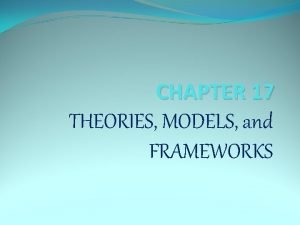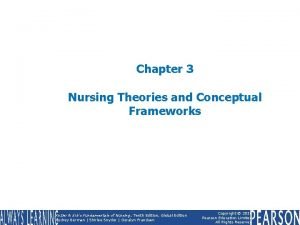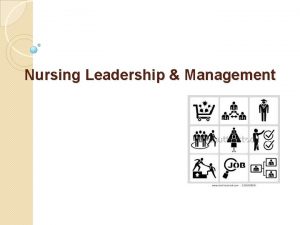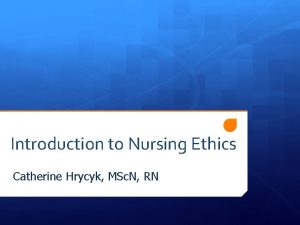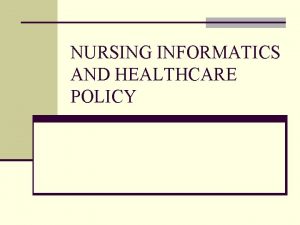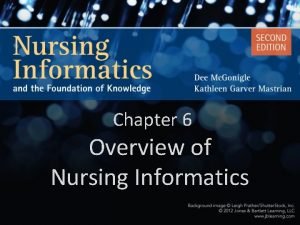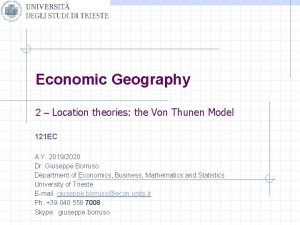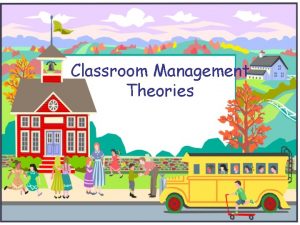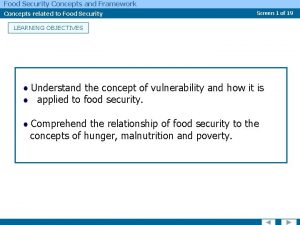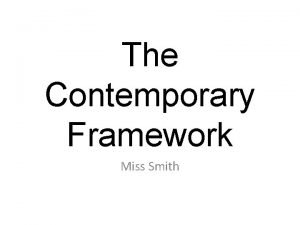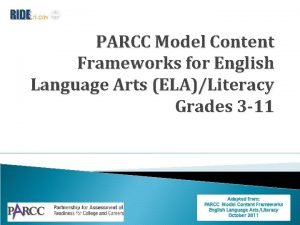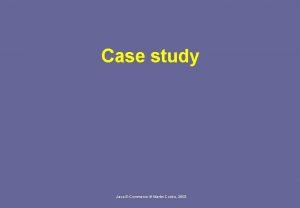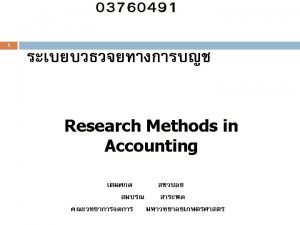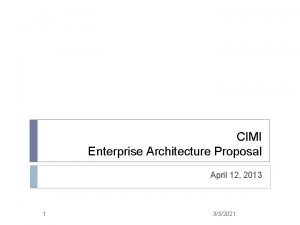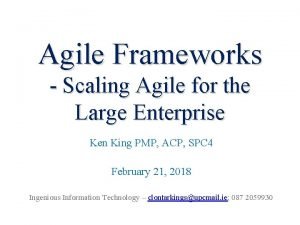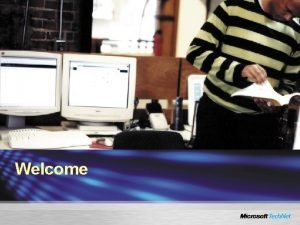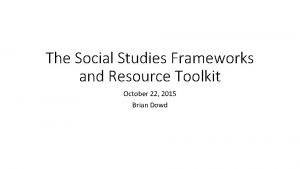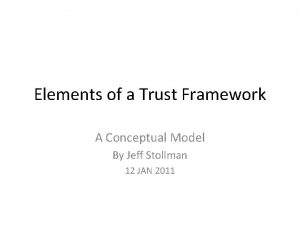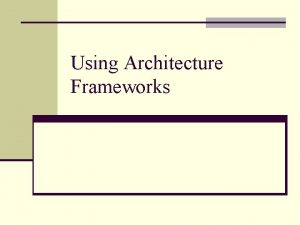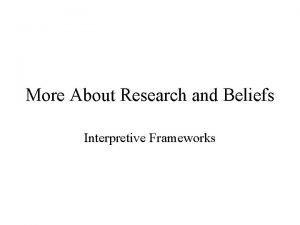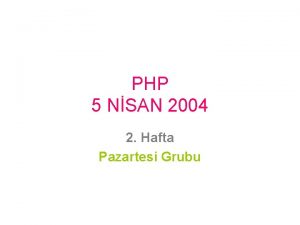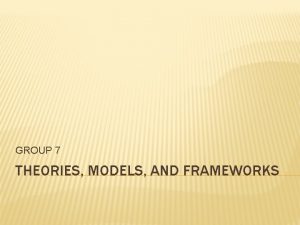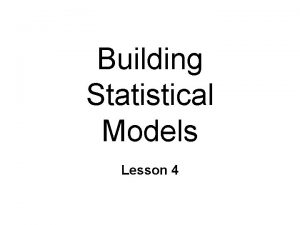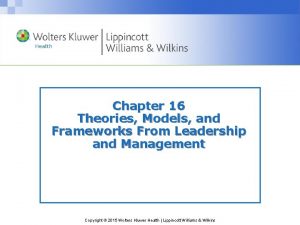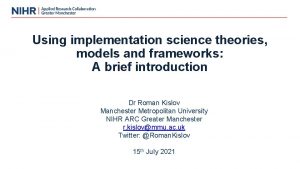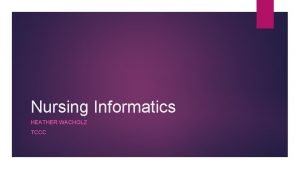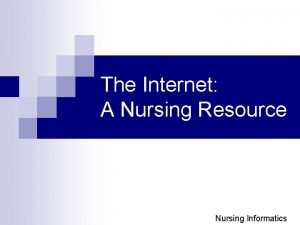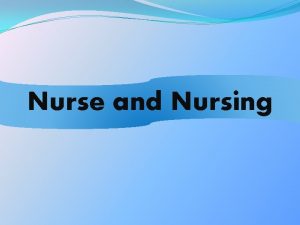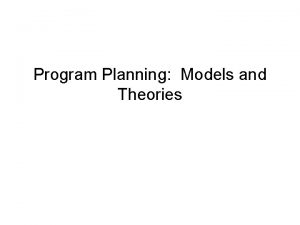Theories Models and Frameworks Nursing Informatics Is an






























- Slides: 30

Theories, Models and Frameworks

Nursing Informatics Ø Is an established and growing area of specialization in nursing. Ø Informatics nurses are key persons in designs, development, implementation, and evaluation of these technologies and in the development of the specialty’s body of knowledge.

Informatics and Healthcare Informatics Ø Informatics is a science that combines a domain science, computer science, information science, and cognitive. Ø Healthcare informatics may be defined as the integration of healthcare sciences, computer, information, and cognitive science to assist in the management of healthcare information.

Nursing Informatics Models Ø Ø Ø Graves and Corcoran’s model Schiwirian’s model Turley’s model Data Information Knowledge (D-I-K) model Benner’s Novice to Expert model

Graves and Corcoran’s Model (1989) q Nursing Informatics as a linear progression – from data into information and knowledge. q Management processing is integrated within each elements, depicting nursing informatics as the proper management of knowledge – from data as it is converted into information and knowledge.

Management Data Information Knowledge

Schiwirian’s Model (1989) q Nursing informatics involves identification of information needs, resolution of the needs, and attainment of nursing goals/objectives. Patricia Schiwirian- proposed a model intended to stimulate and guide systematic in nursing informatics. q Model/framework that enables identification of significant information needs that can foster research (somewhat similar to Maslow’s hierarchy of needs) q

GOAL USERS TECHNOLOGY RAW MATERIALS (Nursing related informatics)

TURLEY’S MODEL (1996) Nursing informatics is the interaction between the discipline-specific science (nursing) and the areas of informatics q Core components of informatics: § Cognitive science § Information science § Computer science •

COMPUTER SCIENCE NURSING INFORMATION SCIENCE COGNITIVE SCIENCE

DATA-INFORMATIONKNOWLEDGE MODEL NI is a specialty that integrates nursing science, computer science and information science to manage and communicate data, information, knowledge and wisdom into nursing practice (ANA). q NI is an evolving, dynamic process involving the conversion of data into information, subsequently knowledge. q Important Note: Processing of information does not always result in the development of knowledge. q

C O M P L E X I T Y KNOWLEDGE INFORMATION DATA HUMAN INTELLECT

BENNER’S LEVEL OF EXPERTISE MODEL q Every nurses must be able to continuously exhibit the capability to acquire skill ( in this case, computer literacy skills parallel with nursing knowledge) and then demonstrate specific skills beginning with the very first student experience.

Levels of Expertise (Benner): Novice- individuals with no experience of situations and related content in those situations where they are expected to perform tasks. § Advance Beginner- marginally demonstrate acceptable performance having built on lessons learned in their expanding experience base; needs supervision. § Competence- enhanced mastery and the ability to cope with and manage contingencies. §

Proficient- evolution through continuous practice of skills, combined with professional experience and knowledge; individual who appreciates standards of practice as they apply in nursing informatics. § Expert- individual with mastery of the concept and capacity to intuitively understand the situation and immediately target the problem with minimal effort or problem solving. §

EXPERT PROFICIENT COMPETENT ADVANCE BEGINNER NOVICE

PATIENT MEDICAL RECORD INFORMATION (PMRI): BASIS OF EHR The type and pattern of documentation in the patient record will be dependent on 3 interacting dimensions of health care: • Personal health dimensions- PHR maintained and controlled by the individual or family; nonclinical information. E. g. . Self-care trackers, directories of health care, and other supports • Health care provider dimension- promotes quality patient care, access to complete accurate patient data 24/7. E. g. . provider’s notes/prescription, clinical orders decision support system, practice guidelines •

§ Population health dimension- information on the health of the population and the influences to health; helps stakeholders identify and track health threats, assess population health, create and monitor programs and services and conduct research e. g. Ushahidi program

Important Terminologies (Data Sets): § § § § ABC codes Perioperative Nursing Data Set (PNDS) SNOMED CT International Classification for Nursing Practice (ICNP) Patient Care Data Set (PCDS) NANDA LOINC

ABC CODES q Mechanism for coding integrative health interventions by clinician for administrative billing and insurance claims q Includes complementary alternative medicine intervention and codes that map all NIC, CCC, and Omaha system interventions

Perioperative Nursing Data Set (PNDS) q Universal language for perioperative nursing practice and education; standardize documentation of perioperative data in all perioperative settings. q Diagnosis based on NANDA intervention based on NIC, and outcomes based on NOC

SNOMED CT q Core clinical terminology containing over 357, 000 healthcare concepts with unique meaning and formal logic-based definitions organized into multiple hierarchies.

International Classification for Nursing Practice (ICNP) q Integrated terminology for nursing practice developed under sponsorship of ICNP elements: Nursing phenomena (nursing diagnosis) § Nursing actions (nursing interventions) § Nursing outcomes §

Patient Care Data Set (PCDS) q Terms and codes for patient problems, therapeutic goals, and care orders. q Developed by Dr. Judith Osbolt

NANDA Has evolved from an alphabetical listing in the mid- 1980’s to a conceptual system that guides the classification of nursing diagnoses in a taxonomy and includes definitions and defining characteristics. q Currently includes 167 recognized diagnoses focus of the terms used for medicine and third party payment claims. q

Logical Observation Identifiers Names and Codes (LOINC) Originated as database of standardized laboratory terms for results reporting for chemistry, hematology, microbiology, serology and toxicology. q Including a clinical portion with codes for observations at key stages of the nursing process, including assessments, goals, and outcomes. Such entries V/S, I&O. ECG and etc. q

ORGANIZATION as resources AMIA § NLN § HIMSS §

American Medical Informatics Association (AMIA) • Authoritative body in the field of medical informatics and frequently represents the US in the informational area of medical forums. • Dedicated to the development and application of medical informatics in the support of patient care, teaching, research and healthcare administration

National League for Nursing (NLN) � Mission: to advance quality nursing education that prepares the nursing workforce to meet the needs of diverse population in an ever-changing healthcare environment. � Addresses faculty development and educational research

Healthcare Information and Management Systems Society (HIMSS) � Assumes leadership role in the health care information technology standards of nursing and advocacy of key innovations in health care delivery and administration.
 Nursing informatics theories, models and frameworks
Nursing informatics theories, models and frameworks The living tree of nursing theories
The living tree of nursing theories Likert leadership theory
Likert leadership theory Beneficence
Beneficence Nursing informatics and healthcare policy
Nursing informatics and healthcare policy Dikw examples in nursing
Dikw examples in nursing Goals of nursing informatics
Goals of nursing informatics Von thunen location theory
Von thunen location theory Demography ap human geography
Demography ap human geography The ginott model
The ginott model Management models and theories
Management models and theories What is the difference between model and semi modal
What is the difference between model and semi modal Food security concepts and frameworks
Food security concepts and frameworks Arnoldo hax
Arnoldo hax Sub topic sentence
Sub topic sentence Contemporary framework
Contemporary framework Parcc model content frameworks
Parcc model content frameworks Java ecommerce framework
Java ecommerce framework List of theoretical frameworks
List of theoretical frameworks Architecture frameworks
Architecture frameworks Enterprise agile frameworks
Enterprise agile frameworks I hate frameworks
I hate frameworks Social studies toolkit
Social studies toolkit Describe trust frameworks.
Describe trust frameworks. Actor frameworks
Actor frameworks Gary ives west yorkshire study
Gary ives west yorkshire study Software architecture frameworks
Software architecture frameworks Interpretative framework
Interpretative framework Regional construction frameworks
Regional construction frameworks Interpretive framework examples
Interpretive framework examples Php frameworks
Php frameworks
